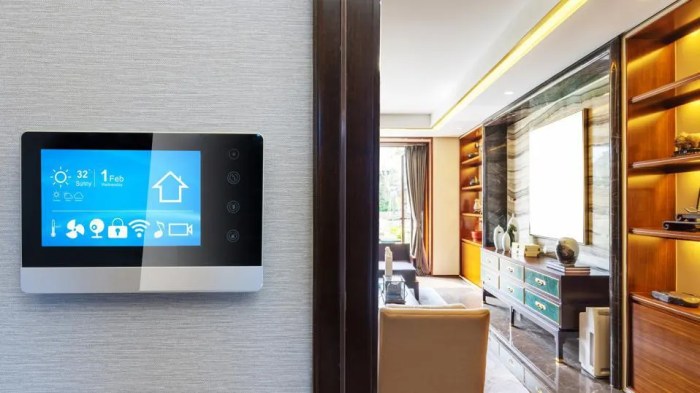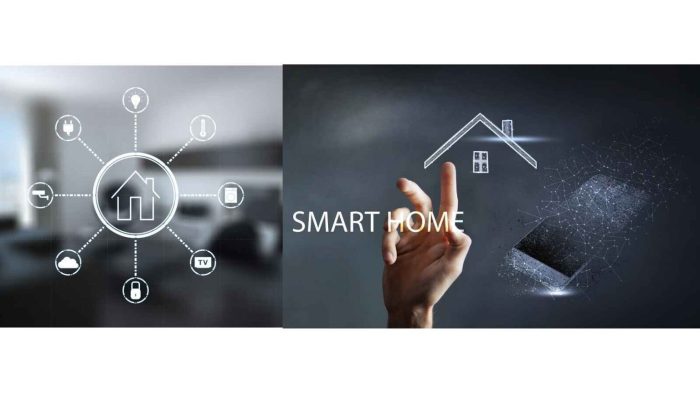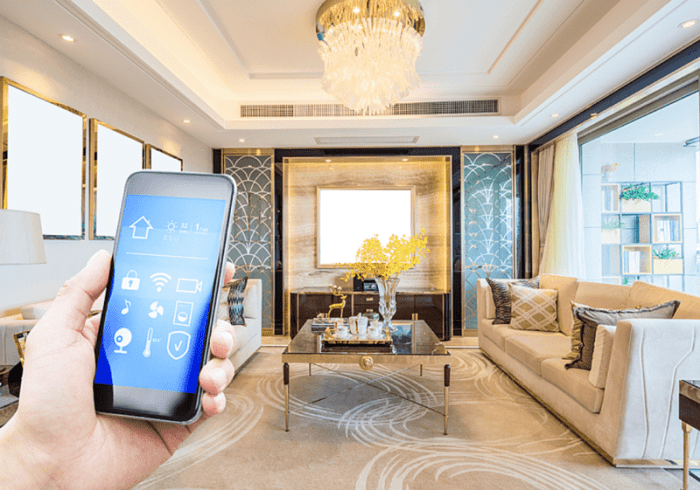As we embark on a new year, the world of smart home technology continues to evolve at an astonishing pace. With a plethora of innovative devices and systems available, homeowners have the opportunity to transform their living spaces into havens of convenience, efficiency, and security.
From smart lighting to intelligent thermostats, voice-controlled assistants to cutting-edge security systems, the possibilities for smart home upgrades in 2023 are endless. Let’s delve into the exciting world of smart home technology and explore how it can enhance your lifestyle.
From automating mundane tasks to creating personalized experiences, smart home upgrades are redefining the way we live. Imagine waking up to a room filled with gentle light, thanks to smart lighting systems that mimic the natural sunrise. Smart thermostats learn your preferences and adjust the temperature accordingly, saving energy and ensuring maximum comfort.
Voice assistants like Amazon Alexa and Google Assistant put the power of control at your fingertips, allowing you to operate devices and access information with just a simple voice command.
Smart Home Automation
In the modern era of technology, smart home automation has emerged as a revolutionary concept, transforming the way people interact with their living spaces. It involves the seamless integration of connected devices, sensors, and systems to create a unified and intelligent ecosystem that responds to occupants’ needs and preferences.
The benefits of smart home automation are multifaceted. It enhances convenience by enabling remote control and automation of various household functions. Energy efficiency is optimized as devices can be programmed to operate efficiently, reducing energy consumption. Enhanced security is achieved through smart locks, motion sensors, and security cameras that safeguard the home and its occupants.
Furthermore, smart home systems offer personalized experiences by learning and adapting to individual routines, providing a tailored and intuitive living environment.
Common Smart Home Devices
Smart home automation encompasses a wide range of devices that work together to create a connected home. These devices can be categorized based on their functions:
- Lighting Control: Smart light bulbs and switches allow users to control lighting remotely, set schedules, and adjust brightness levels.
- Thermostats: Smart thermostats learn and adapt to occupants’ heating and cooling preferences, optimizing energy usage and providing personalized comfort.
- Smart Plugs: These devices enable users to control non-smart appliances by converting them into smart devices, allowing for remote control and scheduling.
- Security Systems: Smart security systems include motion sensors, door and window sensors, and security cameras that detect and alert occupants of potential threats.
- Smart Speakers and Voice Assistants: Voice assistants like Amazon Alexa, Google Assistant, and Apple Siri allow users to control smart home devices using voice commands, providing a hands-free and intuitive way to manage the home.
Integration with Voice Assistants
Voice assistants play a crucial role in smart home automation by providing a natural and intuitive way to interact with smart devices. By using voice commands, users can control various aspects of their home, such as turning on lights, adjusting thermostats, locking doors, and playing music.
This seamless integration enhances the user experience, making smart home automation more accessible and user-friendly.
Smart Lighting Upgrades

Embrace the future of home lighting with smart lighting systems, offering unparalleled energy efficiency and convenience. These systems empower you to control your lights from anywhere, using your smartphone or voice commands. Dive into the world of smart lighting and discover the benefits that await you.
Smart Lighting Options:
Smart lighting systems encompass a diverse range of options, catering to various preferences and needs. Explore the different types of smart lighting solutions available:
- Smart Bulbs: Replace your traditional bulbs with smart bulbs that connect to your home Wi-Fi network. Control them remotely, adjust brightness, and even change colors.
- Smart Switches: Upgrade your existing light switches to smart switches, enabling you to control your lights from your smartphone or voice assistant.
- Smart Dimmers: Enhance your lighting experience with smart dimmers that allow you to adjust the brightness of your lights, creating the perfect ambiance for any occasion.
Color-Changing LED Lights:
Incorporate color-changing LED lights into your smart home setup and unlock a world of possibilities. These lights offer a wide spectrum of colors, allowing you to personalize your lighting to match your mood, decor, or occasion. From vibrant hues to soft pastels, create a captivating atmosphere with the touch of a button.
Smart Thermostats and Energy Management
Smart thermostats are a crucial part of optimizing energy consumption in modern homes. They offer a range of features and functionalities that allow homeowners to control and manage their heating and cooling systems more efficiently, leading to reduced energy bills and improved comfort.
Features and Functionality of Smart Thermostats
Smart thermostats typically come with a variety of features that make them a valuable addition to any home. These features include:
- Remote Control: Smart thermostats can be controlled remotely using a smartphone app, allowing homeowners to adjust the temperature, set schedules, and monitor energy usage from anywhere.
- Scheduling: Smart thermostats allow homeowners to create heating and cooling schedules that match their daily routines. This ensures that the home is always at a comfortable temperature when they need it, while minimizing energy usage when they are away.
- Geofencing: Some smart thermostats use geofencing technology to automatically adjust the temperature based on the location of the homeowner’s smartphone. This ensures that the home is always at a comfortable temperature when they arrive, without wasting energy when they are away.
- Energy Monitoring: Smart thermostats track energy usage and provide homeowners with detailed reports on their heating and cooling costs. This information can be used to identify areas where energy savings can be made.
Benefits of Smart Thermostats
Smart thermostats offer a number of benefits to homeowners, including:
- Reduced Energy Bills: Smart thermostats can help homeowners save money on their energy bills by optimizing the heating and cooling system’s performance. By using scheduling and geofencing features, smart thermostats can reduce energy usage by up to 30%.
- Improved Comfort: Smart thermostats allow homeowners to create heating and cooling schedules that match their daily routines, ensuring that the home is always at a comfortable temperature when they need it.
- Convenience: Smart thermostats can be controlled remotely using a smartphone app, making it easy for homeowners to adjust the temperature, set schedules, and monitor energy usage from anywhere.
- Environmental Impact: Smart thermostats can help homeowners reduce their carbon footprint by reducing energy consumption. This can help to mitigate the effects of climate change.
Smart Security Systems

Smart security systems have revolutionized home security, providing homeowners with advanced features and peace of mind. They combine cutting-edge technology with intuitive user interfaces, creating a robust and customizable security solution.Smart security systems typically consist of several components, including smart locks, motion sensors, and security cameras.
These devices work together seamlessly, monitoring and protecting the home from potential threats.
Smart Locks
Smart locks offer a convenient and secure alternative to traditional locks. They can be controlled remotely via a smartphone app, allowing homeowners to lock or unlock the door from anywhere. Some smart locks also feature biometric authentication, such as fingerprint or facial recognition, for added security.
Motion Sensors
Motion sensors detect movement within a specific area, triggering an alert when motion is detected. They can be placed in strategic locations throughout the home, such as hallways, entrances, and windows, to provide comprehensive coverage.
Security Cameras
Security cameras capture video footage of the home’s surroundings, allowing homeowners to monitor activity remotely. They can be equipped with night vision, motion detection, and facial recognition capabilities, providing a comprehensive security solution.
Smart Home Entertainment
Smart home entertainment systems have revolutionized the way we experience media and entertainment in our homes. These systems offer a wide range of features that enhance our viewing, listening, and gaming experiences.
Smart TVs
Smart TVs are at the heart of many smart home entertainment systems. They offer a variety of features, including:
- Access to streaming services like Netflix, Hulu, and Amazon Prime Video
- Built-in apps for social media, music, and games
- Voice control using virtual assistants like Alexa and Google Assistant
- Screen mirroring from smartphones and tablets
Streaming Devices
Streaming devices like Roku, Apple TV, and Chromecast offer a more affordable way to add smart features to your TV. They plug into your TV’s HDMI port and allow you to access a wide range of streaming services and apps.
Home Theater Systems
Smart home theater systems provide a truly immersive entertainment experience. They typically include a receiver, speakers, and a subwoofer. Some systems also include a Blu-ray player or DVD player.
Integration with Other Smart Devices
Smart home entertainment systems can be integrated with other smart devices in your home for a seamless experience. For example, you can use your voice to control your TV, adjust the lighting, and turn on the fireplace.
Smart Home Assistants and Voice Control

Smart home assistants have become integral to the smart home experience, providing a convenient and intuitive way to control and manage smart devices. These assistants use voice commands to interact with users, allowing them to control lighting, thermostats, entertainment systems, and more, hands-free.
Popular Smart Home Assistants
There are several popular smart home assistants available, each with its own unique features and capabilities. Some of the most well-known include:
- Amazon Alexa: Alexa is Amazon’s smart home assistant, known for its wide range of skills and integrations with various smart devices. It can control smart lights, thermostats, music players, and more, and can also provide information, set alarms, and manage to-do lists.
- Google Assistant: Google Assistant is Google’s smart home assistant, which offers a similar range of features to Alexa. It can control smart devices, provide information, play music, and manage tasks. Google Assistant is also deeply integrated with Google’s other services, such as Gmail, Calendar, and Maps.
- Apple Siri: Siri is Apple’s smart home assistant, primarily designed for use with Apple devices. It can control HomeKit-compatible smart devices, such as lights, thermostats, and door locks. Siri can also provide information, set alarms, and manage tasks.
Benefits of Voice Control
Voice control offers several benefits in the smart home environment:
- Convenience: Voice control allows users to control their smart devices without having to lift a finger. This is especially useful for tasks that require multiple steps or for controlling devices that are difficult to reach.
- Safety: Voice control can also improve safety in the home. For example, users can use voice commands to turn on lights when they enter a room, or to lock the door when they leave.
- Accessibility: Voice control can make smart homes more accessible for people with disabilities. For example, users with mobility issues can use voice commands to control their lights, thermostats, and other devices without having to move around.
Smart Home Connectivity and Networking

A robust and reliable home network is the foundation of a seamless smart home experience. With multiple devices communicating and exchanging data, a strong network infrastructure is crucial for ensuring smooth operation and minimizing disruptions.
Types of Home Networking Technologies
There are several types of home networking technologies available, each with its own advantages and limitations:
- Wi-Fi: The most common type of home networking technology, Wi-Fi provides wireless connectivity to devices within its range. It is easy to set up and offers good speeds, but can be susceptible to interference and dead spots.
- Ethernet: A wired connection, Ethernet offers the fastest and most reliable speeds, but requires cables to be run through walls or along baseboards. It is ideal for devices that require high bandwidth, such as streaming media players and gaming consoles.
- Powerline Networking: Powerline networking uses existing electrical wiring to transmit data, providing a wired connection without the need for additional cables. It is a good option for extending the reach of a wired network to areas where Wi-Fi is weak or unavailable.
Benefits of Mesh Wi-Fi Systems
For homes with multiple rooms or levels, mesh Wi-Fi systems offer a solution to eliminate dead spots and ensure seamless connectivity throughout the house. These systems consist of multiple Wi-Fi nodes that work together to create a single, unified network.
- Improved Coverage: Mesh Wi-Fi systems extend the range of your Wi-Fi network, eliminating dead spots and ensuring that devices can connect from anywhere in the house.
- Faster Speeds: Mesh Wi-Fi systems can provide faster speeds than traditional Wi-Fi routers, especially in areas where the signal is weak.
- Reduced Interference: Mesh Wi-Fi systems use multiple nodes to distribute the network load, reducing interference and improving overall performance.
- Easy to Set Up and Manage: Most mesh Wi-Fi systems are easy to set up and manage, with user-friendly apps that allow you to control the network and make changes as needed.
Smart Home Data Privacy and Security
Smart home devices and systems are increasingly becoming a part of our daily lives, offering convenience and automation. However, these devices also collect and transmit a significant amount of data, raising concerns about data privacy and security.Understanding these concerns and implementing proper security measures is crucial to protect your smart home from potential threats and ensure your data remains private.
Encryption and Authentication
Encryption plays a vital role in securing smart home data. It ensures that data transmitted between devices and the cloud is protected from unauthorized access, even if intercepted. Look for devices that support strong encryption standards like AES-256 or TLS 1.2.Authentication
mechanisms are also essential for preventing unauthorized access to your smart home network and devices. Strong passwords and multi-factor authentication (MFA) add an extra layer of security, making it more difficult for attackers to gain access.
Network Security
Securing your smart home network is paramount to protecting your devices and data. Use a strong and unique password for your Wi-Fi network, and enable WPA2 encryption or higher. Regularly update your router’s firmware to patch any security vulnerabilities.Consider using a separate network for your smart home devices, isolating them from your personal devices and reducing the risk of compromise.
Device Security
Keep your smart home devices up to date with the latest firmware and software updates. These updates often include security patches that fix vulnerabilities and protect your devices from known threats.Be cautious when installing third-party apps or services on your smart home devices.
Only install apps from trusted sources and carefully review their privacy policies before granting them access to your data.
Physical Security
Physical security measures can also help protect your smart home from unauthorized access. Install smart locks on your doors and windows, and consider adding motion sensors or security cameras to deter intruders.Educate family members and guests about smart home security practices, such as using strong passwords and being cautious when connecting to public Wi-Fi networks.
Smart Home Trends and Innovations

The smart home industry is constantly evolving, with new trends and innovations emerging every year. These advancements are driven by technological advancements, changing consumer preferences, and a growing focus on sustainability and energy efficiency. Here are some key trends and innovations shaping the future of smart living:
Integration and Interoperability
One of the key trends in smart home technology is the increasing integration and interoperability between different devices and platforms. This allows homeowners to seamlessly connect and control all their smart devices from a single app or interface. This trend is being driven by the development of open standards and protocols, such as Matter, which enables different smart home devices to communicate with each other regardless of their brand or manufacturer.
Artificial Intelligence and Machine Learning
Artificial intelligence (AI) and machine learning (ML) are playing an increasingly important role in smart home systems. These technologies allow smart home devices to learn from user behavior and preferences, and to make automated decisions accordingly. For example, a smart thermostat can learn a homeowner’s preferred temperature settings and adjust the temperature accordingly, while a smart lighting system can learn when a homeowner is home and turn on the lights automatically.
Voice Control and Natural Language Processing
Voice control and natural language processing (NLP) are becoming increasingly popular ways to interact with smart home devices. This allows homeowners to control their devices using simple voice commands, such as “turn on the lights” or “set the thermostat to 72 degrees.”
This trend is being driven by the increasing popularity of voice assistants, such as Amazon Alexa, Google Assistant, and Apple Siri.
Energy Efficiency and Sustainability
The growing focus on sustainability and energy efficiency is also driving innovation in the smart home industry. Smart home devices can help homeowners reduce their energy consumption and save money on their utility bills. For example, smart thermostats can learn a homeowner’s heating and cooling preferences and adjust the temperature accordingly, while smart lighting systems can turn off lights when a room is empty.
Cybersecurity and Data Privacy
As smart home devices become more connected and collect more data, cybersecurity and data privacy are becoming increasingly important concerns. Smart home manufacturers are investing in security measures to protect user data from unauthorized access and cyberattacks. Homeowners should also take steps to protect their smart home systems by using strong passwords and keeping their devices up to date with the latest security patches.
Smart Home Integration and Compatibility
In a smart home ecosystem, the seamless integration and compatibility of various devices play a crucial role in delivering a unified and user-friendly experience. This section delves into the significance of device compatibility and interoperability, explores smart home platforms and ecosystems that facilitate seamless integration, and highlights the importance of open standards and protocols in promoting compatibility among smart home devices.
Device Compatibility and Interoperability
Device compatibility refers to the ability of different smart home devices to communicate and work together seamlessly, regardless of their brands or manufacturers. Interoperability, on the other hand, is the extent to which these devices can exchange data and interact with each other in a meaningful way.
Both compatibility and interoperability are essential for creating a cohesive smart home system that operates smoothly and efficiently.
Smart Home Platforms and Ecosystems
Several smart home platforms and ecosystems have emerged to address the challenges of device compatibility and interoperability. These platforms provide a centralized hub that allows users to connect and control various smart devices from different manufacturers. Some popular examples include:
- Amazon Alexa: Amazon’s voice-activated assistant and smart home platform enables users to control compatible devices using voice commands.
- Google Home: Google’s smart home platform offers voice control, device integration, and a range of smart home products.
- Apple HomeKit: Apple’s smart home platform allows users to control compatible devices using the Apple Home app or Siri voice commands.
- Samsung SmartThings: Samsung’s smart home platform provides a comprehensive suite of features for device integration, automation, and remote control.
Open Standards and Protocols
Open standards and protocols play a vital role in promoting compatibility and interoperability among smart home devices. These standards define common communication methods and data formats, ensuring that devices from different manufacturers can understand and communicate with each other. Some key open standards and protocols in the smart home industry include:
- Wi-Fi: A wireless networking technology that allows smart devices to connect to the internet and communicate with each other.
- Zigbee: A low-power wireless communication protocol specifically designed for smart home devices.
- Z-Wave: Another low-power wireless protocol commonly used in smart home systems.
- Bluetooth: A short-range wireless technology used for connecting devices such as smart speakers and smart thermostats.
By adhering to open standards and protocols, smart home device manufacturers can ensure that their products are compatible with a wide range of other devices and platforms, creating a more cohesive and user-friendly smart home experience.
Outcome Summary
As we move forward into 2023, the future of smart home technology holds boundless possibilities. With the rapid advancement of artificial intelligence and machine learning, we can expect even more intuitive and personalized smart home experiences. The integration of smart devices with renewable energy sources will further enhance sustainability and reduce our environmental impact.
As smart home technology continues to evolve, it promises to transform our living spaces into havens of comfort, convenience, and efficiency. Embrace the possibilities and embark on a journey towards a smarter, more connected home.
FAQ Summary
What are the key benefits of smart home automation?
Smart home automation offers a range of benefits, including increased convenience, energy efficiency, enhanced security, and personalized experiences.
How can smart lighting systems improve energy efficiency?
Smart lighting systems allow for precise control over lighting, enabling homeowners to reduce energy consumption by dimming or turning off lights when not in use.
What are the advantages of using smart thermostats?
Smart thermostats optimize home energy consumption by learning heating and cooling preferences and adjusting the temperature accordingly, resulting in reduced energy bills and improved comfort.
How do smart security systems enhance home security?
Smart security systems provide enhanced protection through features like remote monitoring, motion sensors, and security cameras, enabling homeowners to keep an eye on their property from anywhere.
What are the latest trends in smart home entertainment?
The latest trends in smart home entertainment include the integration of smart TVs, streaming devices, and home theater systems, allowing for personalized content recommendations and seamless control.